Fantasia 2016, Day 10 Part 1: Sequels and New-Told Tales (Assassination Classroom: Graduation, Revoltoso, Nova Seed, and the Samsung Virtual Reality Experience)
 Saturday, July 23, was going to be a long day for me at the Fantasia film festival, filled with some tough choices about what to watch. Some of those choices were clarified early on, when thanks to the good work of the people at Fantasia I was able to watch a screener of Assassination Classroom: The Graduation. That resolved a schedule conflict later in the day, and just after noon I’d see my first theatrical screening: Nova Seed, a Canadian animated feature that was playing with an almost half-hour-long short film from Mexico, Revoltoso. After that I had a couple hours until the next set of movies, and I planned to get a good meal. This did not happen. Instead I’d end up taking a test drive of the future — or what seems to me like the future, or at least like a future.
Saturday, July 23, was going to be a long day for me at the Fantasia film festival, filled with some tough choices about what to watch. Some of those choices were clarified early on, when thanks to the good work of the people at Fantasia I was able to watch a screener of Assassination Classroom: The Graduation. That resolved a schedule conflict later in the day, and just after noon I’d see my first theatrical screening: Nova Seed, a Canadian animated feature that was playing with an almost half-hour-long short film from Mexico, Revoltoso. After that I had a couple hours until the next set of movies, and I planned to get a good meal. This did not happen. Instead I’d end up taking a test drive of the future — or what seems to me like the future, or at least like a future.
First, Assassination Classroom: The Graduation, directed (like the first live-action Assassination Classroom film) by Eiichiro Hasumi, from a script by Tatsuya Kanazawa based on a manga by Yuusei Matsui. I saw part one of the Assassination Classroom story last year at Fantasia and loved it. A whirlwind science-fiction comedy, it followed a high school class in Japan filled with underachievers, given the mission to kill their new teacher before the end of the school year. That professor, dubbed “UT” for “Unkillable Teacher,” was a grinning yellow smiley-face with tentacles who could move at supersonic speeds and had already blown up the moon. The more the movie went on the more imaginative and frenetic it got, adding characters and sub-plots with abandon.
The second movie keeps some of the same tone, but immediately begins deepening it: the students have to start thinking about their career paths, letting us know that their time with UT is almost up one way or another. A school festival starts out with the same surrealist humour as the first movie, as a government sniper attempts to infiltrate the festival to kill UT — who in the meanwhile has cast himself as the lead in a stage performance of the Momotaro story. Again, though, some of the goings-on here are darker, as two of the girls are briefly taken prisoner by older boys demanding sexy pictures. The girls rescue themselves, but the tone’s definitely taken a turn.
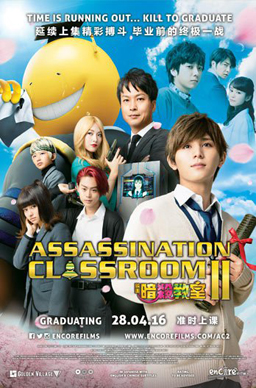 That’s confirmed as the story moves into an extended flashback which gives us UT’s origin and explains some of the mysteries left over from the first movie. It’s done well enough, but lacks the speed and the surprises of the first movie. On its own, the flashback sequence is a perfectly solid sf-action-romance set-piece, but like many extended flashbacks it delivers a stiff check to any sense of narrative momentum. The movie feels like it breaks down into the bit before the flashback, the flashback, and then the wrap-up.
That’s confirmed as the story moves into an extended flashback which gives us UT’s origin and explains some of the mysteries left over from the first movie. It’s done well enough, but lacks the speed and the surprises of the first movie. On its own, the flashback sequence is a perfectly solid sf-action-romance set-piece, but like many extended flashbacks it delivers a stiff check to any sense of narrative momentum. The movie feels like it breaks down into the bit before the flashback, the flashback, and then the wrap-up.
Once the present-day story resumes, it ramps up quickly. The students, by this time well-trained in the arts of combat and assassination, have to overcome government forces to save their teacher. We see what they’ve learned, and follow them through a series of good action beats to a final climax. It’s effective, and by the end all the mysteries of both films are explained. But this is a film that desperately needs the first movie to make sense. The opening scenes do a creditable job of reintroducing the various characters and reminding us of most of their abilities, but not of why we should care about them — or, for that matter, how they each got involved with UT’s class. Everything fits together perfectly, but you need to see the first movie to understand that.
On its own, Assassination Classroom:The Graduation is (I would think) coherent enough but structurally bizarre. You’re dropped into a weird situation, go into a very long flashback, and by the time you get back for an extended set-piece you’ve largely forgotten the original situation. Viewed as the second of the two-movie series, the structure makes much more sense. You’re introduced to the characters in the first one, the tone darkens, you get a flashback that answers all the questions that’ve been percolating about the mysterious UT, and then you get a nice long action-filled climax. As the second half of the Assassination Classroom story, it’s perfectly solid.
 But it’s not great. The first film was great, to my mind, and if this movie had kept the same frenetic and inventive tone of that one, this would be an unmissable series. There are some tremendously funny moments, mostly courtesy of Kang Ji-young’s secret-agent-turned-undercover-teacher Irina Jelavic (as seen at right). She’s an old-fashioned sexpot spy, but it’s so over-the-top it works: when she distracts a government operative by smooching him, we see when she’s done that he’s not just left dizzy but also covered with iconic double-lip lipstick smears. It’s a nicely cartoony gag, recalling some of the oddball antics of part one.
But it’s not great. The first film was great, to my mind, and if this movie had kept the same frenetic and inventive tone of that one, this would be an unmissable series. There are some tremendously funny moments, mostly courtesy of Kang Ji-young’s secret-agent-turned-undercover-teacher Irina Jelavic (as seen at right). She’s an old-fashioned sexpot spy, but it’s so over-the-top it works: when she distracts a government operative by smooching him, we see when she’s done that he’s not just left dizzy but also covered with iconic double-lip lipstick smears. It’s a nicely cartoony gag, recalling some of the oddball antics of part one.
I would have liked more of those antics. In theory I appreciate the idea of a sequel that does something different from its original, but these two movies are really one story. The point of division between them is logical enough, and you can certainly understand what the filmmakers had in mind. But the result is disappointing. Not just the absurdity is missing, but also the first movie’s ability to take itself lightly. The flashback sequence aims at establishing an emotional heart for both movies, I think, but to me went too far and ended up as relatively conventional melodrama.
 Which, again, is different from the first film’s joyous refusal of dramatic convention. There is overall a more mechanical feel to this movie, as loose ends have to be tied up and characters advanced. It’s well-handled — we see how the lead student, Nagisa Shiota (Ryosuke Yamada), has changed over the course of the films and how the whole experience has shaped him — but after the first film it’s somehow pedestrian.
Which, again, is different from the first film’s joyous refusal of dramatic convention. There is overall a more mechanical feel to this movie, as loose ends have to be tied up and characters advanced. It’s well-handled — we see how the lead student, Nagisa Shiota (Ryosuke Yamada), has changed over the course of the films and how the whole experience has shaped him — but after the first film it’s somehow pedestrian.
Overall, the two movies are worth watching together. As a whole, Assassination Classroom is still a heady mix of absurdist comedy and violent coming-of-age story. If it’s difficult to imagine the second film standing alone, at least it wraps up the story of the first half. It doesn’t do it with as much flair, I find, but the story stands up well enough.
After Assassination Classroom it was off to the De Sève Theatre for a double feature of animated films. First was Revoltoso, which at 29 minutes is technically a short. It’s a stop-motion movie from co-directors Arturo and Roy Ambriz, and tells a story that takes place during the Mexican revolution — or, put another way, during the early years of cinema. These things come together as Don Gonzalo, master of a Mexican boar ranch, hires a cowering film director to bring his camera to the ranch and record what he sees. But all the while, revolutionaries are on the march. And the boars, especially one curious runt, may have ideas of their own. The climax brings film and rebellion together nicely.
Rupert Bottenberg, Director of Fantasia’s animation section, noted in his introduction to the film that this is a story about Mexican history made out of Mexican history. The characters are bits and pieces of wood and fabric, the settings unreal and abstract. The Don seems to be made of brass and scraps of uniform cloth. There is a definite cubist influence in the visuals, particularly in the rebels, perhaps foreshadowing the film’s concern with history and the unstoppable onward movement of time. The opening establishes us in 1913, “the start of a violent century.” But if the Don sees a use in the modern technology of cinema, he’s still the representative of an old order. The rebels are the shock of the new, the railroad whose tracks lead into the future, a visual parallel to unspooled film.
 As this implies, there’s a strongly symbolic feel to the movie, and I don’t know how much subtext I missed by being unfamiliar with the complexities of the Mexican Civil War. What I can say is that the characters are strong enough to hold the film together, and there’s enough comedy — particularly courtesy of that tiny boar — that it’s entertaining quite aside from themes of history and progress. The animation’s fluid, making for an odd contrast as the collage-like characters seem always on the verge of falling to pieces. But they hold up, and so does the film as a whole.
As this implies, there’s a strongly symbolic feel to the movie, and I don’t know how much subtext I missed by being unfamiliar with the complexities of the Mexican Civil War. What I can say is that the characters are strong enough to hold the film together, and there’s enough comedy — particularly courtesy of that tiny boar — that it’s entertaining quite aside from themes of history and progress. The animation’s fluid, making for an odd contrast as the collage-like characters seem always on the verge of falling to pieces. But they hold up, and so does the film as a whole.
Nova Seed followed at once. It was directed by Nick DiLiberto, and written by DiLiberto with his brother Joe. Diliberto also provided the main voice, did all the drawings (with help from his brother as character designer), and performed most other tasks; this is as near a one-man show as it’s possible for an animated film to be. DiLiberto produced over 60,000 drawings in four years to make the film. Remarkably, there’s no sense as you watch that DiLiberto was limited by his resources — there are crowd scenes here (if relatively brief ones), lots of action, and a climax that feels convincingly large in scope.
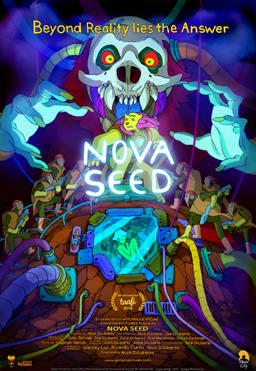 The movie’s a science-fiction story midway between Saturday morning cartoons and the Heavy Metal movie (which I guess averages out to something like Starchaser: The Legend of Orin, or maybe Rock & Rule). There’s an evil villain, Doctor Mindskull, intent on conquering the world. A reluctant hero, a genetically-engineered lion-man gladiator called Neo-Animal Combatant, or Nac. And a mysterious girl who might represent ultimate power. Nac frees her from captivity, and the two are sought by all sides as they hijack a fighter craft and flee across a forbidden badlands.
The movie’s a science-fiction story midway between Saturday morning cartoons and the Heavy Metal movie (which I guess averages out to something like Starchaser: The Legend of Orin, or maybe Rock & Rule). There’s an evil villain, Doctor Mindskull, intent on conquering the world. A reluctant hero, a genetically-engineered lion-man gladiator called Neo-Animal Combatant, or Nac. And a mysterious girl who might represent ultimate power. Nac frees her from captivity, and the two are sought by all sides as they hijack a fighter craft and flee across a forbidden badlands.
The designs are engaging, more than the stills would suggest. The organic hand-drawn feel works well with the bright primary colours and beautifully garish lighting, creating a distinctive look for the film. I feel I must point out that some of the figures lose definition at moments in complex action scenes, but never to an extent that the storytelling’s hampered. In fact the animation’s mostly remarkably smooth, with body language, stance, and gesture helping to build character.
Which is all important because the dialogue is deliberately bare-bones. The sound design is fine, and the soundtrack (sounding a bit like an 80s cartoon, and then also something like Vangelis or maybe even moments of Dead Can Dance) fits the action well. Crucially, character is revealed through action. Nac, the hero, is strong and silent, engaging but stoic. Mindskull gets more dialogue — as the chief bad guy, of course he has to have his monologues. We get enough background to sketch out the story, and then our understanding of what sort of story this is carries us the rest of the way.
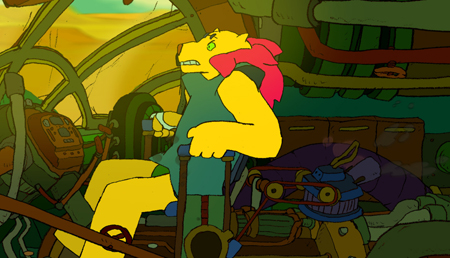 It’s a visual story, then, told cinematically, which is to say visually. And it works, because the storytelling’s strong. And because while the basics of the world are sketched in through brief exposition, it’s mainly built up through design. The props and vehicles and costumes all work together to tell us what kind of a setting this is, what life is like (hard, mostly), and what has priority (weapons, mostly). Things look scavenged, look patched and repaired. It’s a convincing backdrop.
It’s a visual story, then, told cinematically, which is to say visually. And it works, because the storytelling’s strong. And because while the basics of the world are sketched in through brief exposition, it’s mainly built up through design. The props and vehicles and costumes all work together to tell us what kind of a setting this is, what life is like (hard, mostly), and what has priority (weapons, mostly). Things look scavenged, look patched and repaired. It’s a convincing backdrop.
And it’s a solid enough story, a good science-fiction cartoon with some ecological themes. It builds nicely, and there’s an attractive exuberance. There’s an almost old-fashioned hero-story feel. The lead’s a bruiser who fights monsters in an arena. The villain’s a clever guy who still builds a giant unstoppable weapon with its main weakness front and centre. There’s a dead world in need of healing, and a mysterious child who may be able to turn the trick. It calls up memories of animated features past, but more than a recycling of cliches, and more than pastiche, it’s a very solid adventure on its own.
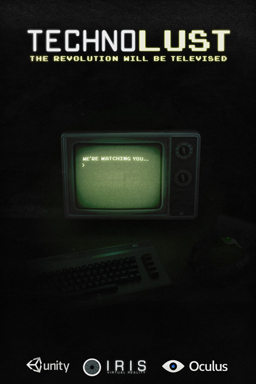 After Nova Seed I found myself at a bit of a loss. I’d been planning to go and get a meal before the three movies I’d see in the evening, but a storm had begun while I’d been in the theatre. I watched gouts of rain beating down against the windows, and decided not to go outside. The De Sève is on the ground floor of Concordia’s Library Building, so I went up and browsed around there for a while. I took out a book, wandered back downstairs, looked out at the still-pouring rain, and then realised there was something else going on in the Library Building ground floor. High black curtains had been set up in the building’s atrium to house what was being called “The Samsung Fantasia Virtual Reality Experience.”
After Nova Seed I found myself at a bit of a loss. I’d been planning to go and get a meal before the three movies I’d see in the evening, but a storm had begun while I’d been in the theatre. I watched gouts of rain beating down against the windows, and decided not to go outside. The De Sève is on the ground floor of Concordia’s Library Building, so I went up and browsed around there for a while. I took out a book, wandered back downstairs, looked out at the still-pouring rain, and then realised there was something else going on in the Library Building ground floor. High black curtains had been set up in the building’s atrium to house what was being called “The Samsung Fantasia Virtual Reality Experience.”
This year, as they had in 2015, Samsung was sponsoring a presentation of virtual reality technology, presenting a number of short films (or film-like pieces) designed for viewing through a VR headset. Last year I’d noticed long lines. This year, at least in the middle of a thunderstorm, there seemed to be less of a crowd. I wandered over to investigate. The curtains made a large room with some swivel chairs set against the black folds. Most of the chairs were empty, so an attendant showed me right in and set me up with a virtual reality headset. I’d have my pick of 11 different short films that would play out all around me. I could watch as many as I liked, up to a total of 15 minutes (with no charge). I made my picks, and got started.
The first film I watched was “Technolust: The Short Film.” Directed by Blair Renaud, it promised “a taste of the award-winning virtual reality adventure set in a near-future cyberpunk world,” in the words of the Fantasia program, and that’s exactly what it delivered (the “award-winning virtual reality adventure” being a larger game or “interactive visual novel”). I found myself being moved through a succession of bars, hallways, and corporate headquarters; before long I was being led to the conclusion across the surface of Mars. The story built quickly through a noir-like plot to a point of science-fictional transcendence. Definitely cyberpunk, it inspired a sense of chronological dissonance. On the one hand, I was watching a tale in a genre from the twentieth century play out on technology from the twenty-first. On the other, the sensation was as immersive as the consensual hallucinations of virtual reality imagined by Gibson in Neuromancer.
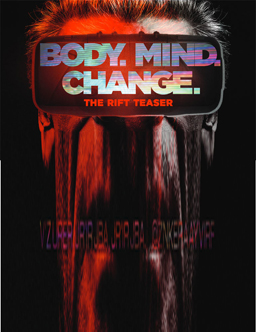 I regret that I can’t say much about the story itself. It unfolded through voice-overs, characters and computers speaking to “me” as “I” was moved through a variety of largely computer-generated cyberpunk imagery. But, frankly, I was distracted by constantly looking around. It’s one thing to know you’re watching a VR film, and another to actually be in a completely immersive story world, with things to look at not just to right and left but above, below, and behind. I remember one moment when I passed a robot staring at me, and turned to watch it watching me; it seemed to hold my gaze until the scene transitioned to the next location. The visuals weren’t perfect — too many of the locations I saw felt peculiarly insubstantial — but the story built very well.
I regret that I can’t say much about the story itself. It unfolded through voice-overs, characters and computers speaking to “me” as “I” was moved through a variety of largely computer-generated cyberpunk imagery. But, frankly, I was distracted by constantly looking around. It’s one thing to know you’re watching a VR film, and another to actually be in a completely immersive story world, with things to look at not just to right and left but above, below, and behind. I remember one moment when I passed a robot staring at me, and turned to watch it watching me; it seemed to hold my gaze until the scene transitioned to the next location. The visuals weren’t perfect — too many of the locations I saw felt peculiarly insubstantial — but the story built very well.
The next film I looked at was called “Body/Mind/Change Redux,” an homage to David Cronenberg again directed by Blair Renaud, this time in collaboration with J. Lee Williams. One is moved, sitting, through a series of settings inspired by Cronenberg’s films, while Cronenberg speaks in the background promising to reveal secrets. The settings here felt more solid, and I was moved in more directions, but the story was more rudimentary than “Technolust.” (Perhaps unsurprising, as this film was only 2 and a half minutes long compared with the 5 minute 50 second “Technolust,” and designed as an extension to a Cronenberg exhibition at the Toronto International Film Festival.) The atmosphere was much stronger, helped by the use of unsettling Cronenbergian imagery, and what seemed more assured and atmospheric lighting.
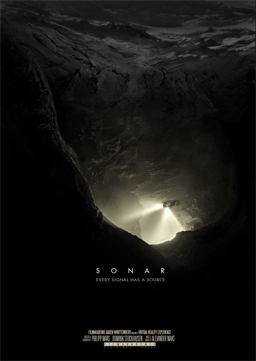 The third and final film I watched was the six-minute “Sonar,” directed by Philipp Maas and Dominik Stockhausen. In this one I followed a drone into a weird cave system, through an oddly beautiful underground world, to a moment of extreme strangeness at the end. This movie was in black-and-white, but oddly felt more immersive than the other films. The point-of-view moved in and out of the drone, and often shrunk down from the full 360-degree world to a much narrower field of vision, concentrating the viewer’s attention on a specific spot. That said, it also used the VR sense of scope more effectively than the other two movies, presenting great vistas and a breathtaking movement from enclosed space into a mysterious abyss. Dialogue was terser here, and the ending mysterious.
The third and final film I watched was the six-minute “Sonar,” directed by Philipp Maas and Dominik Stockhausen. In this one I followed a drone into a weird cave system, through an oddly beautiful underground world, to a moment of extreme strangeness at the end. This movie was in black-and-white, but oddly felt more immersive than the other films. The point-of-view moved in and out of the drone, and often shrunk down from the full 360-degree world to a much narrower field of vision, concentrating the viewer’s attention on a specific spot. That said, it also used the VR sense of scope more effectively than the other two movies, presenting great vistas and a breathtaking movement from enclosed space into a mysterious abyss. Dialogue was terser here, and the ending mysterious.
After watching the three films I came away both deeply affected by the powerful sense of immersion, and also unsure that the technology’s quite there yet. The resolution and focus didn’t seem as smooth as I’d have liked; I was always aware of watching a screen. In this case, it was something like a smartphone screen strapped into a headset right before my eyes, but the effect was the same. It was watchable, but slightly less all-encompassing than I’d expected. I will say that from a physical perspective it was comfortable — I wear glasses, and the VR set fit over top of them. There was enough space for that to work, with my glasses pushed back slightly on my nose. It was tight, but quite wearable. In fact, I found I had more issues getting used to having audio headphones sitting on top of the strap of the VR headset.
The most impressive thing about the movies overall was the sense of motion. All three seemed to pull the viewer onward through a series of locations, and the effect was stunningly well-realised. I felt weightless, at times, particularly in “Sonar.” On the other hand, what was most difficult to get used to was simply the temptation to look around. Was something coming up behind me? Or was there something overhead? It was difficult to follow a reasonably complex plot, such as “Technolust” had, when I was taking the time to look in every direction. Then again, the more meditative “Sonar,” with its longer shots, allowed me to get a grasp of where I was at any given moment and still follow the drone on its lonely voyage. (I’ve heard that some have had issues with motion sickness in VR; I’m not particularly susceptible to motion sickness, but for what it’s worth I had no issues even though all three films had me in near-constant movement.)
Finally the rain let up enough for me to go get a quick bite to eat. It had been a good first half of the day, in all. I’d seen the conclusion to a story I’d liked, watched two animated films clearly made out of real passion, and got a bit of a preview of where technology’s going. Not too bad; and I still had two feature films and a short film showcase to go before the day ended.
(You can find links to all my Fantasia 2016 diaries here.)
Matthew David Surridge is the author of “The Word of Azrael,” from Black Gate 14. You can buy his first collection of essays, looking at some fantasy novels of the twenty-first century, here. His second collection, looking at some fantasy from the twentieth century, is here. You can find him on Facebook, or follow his Twitter account, Fell_Gard.